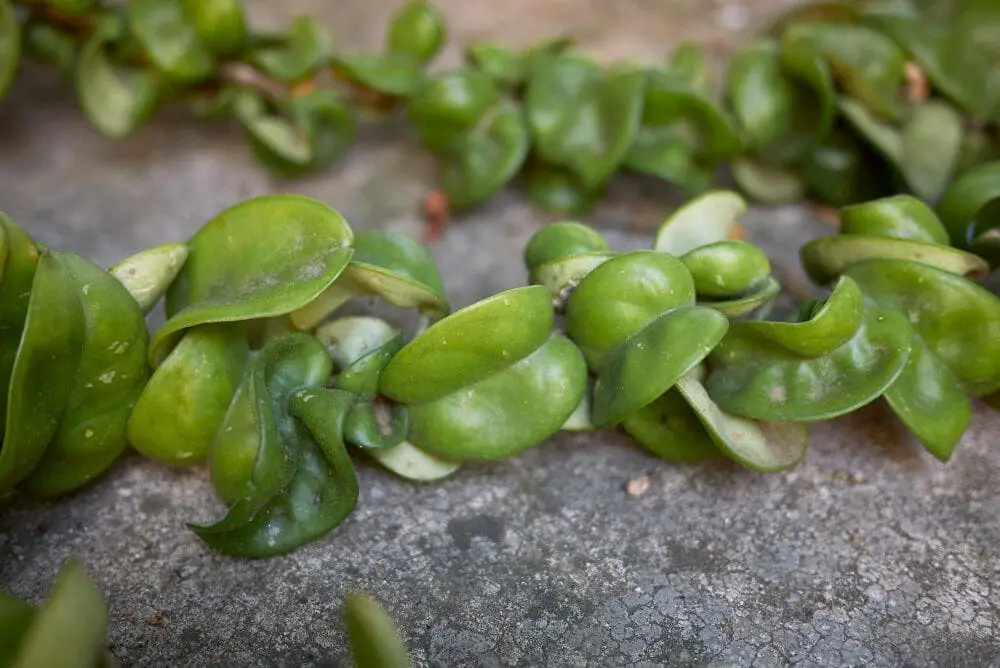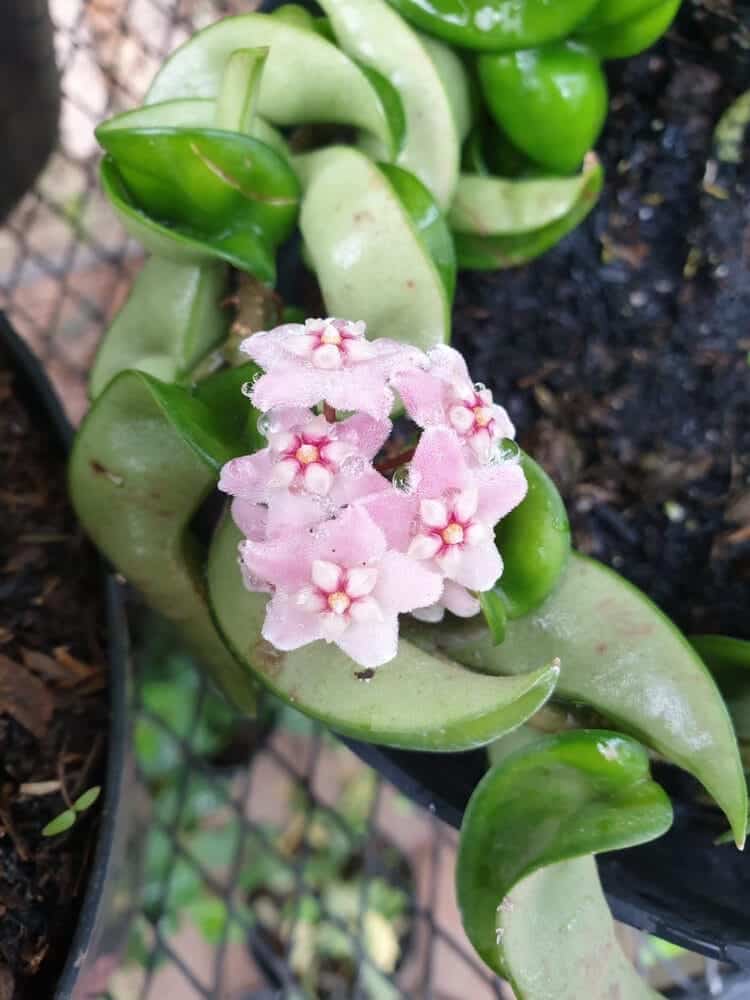If you’re looking for exotic plants that steal the show in any room that it’s in, you need to own a Hindu Rope Plant.
This strange succulent is hardy and robust, but its flowers are beautiful and a great addition to any indoor garden. You’ll see this plant in museums and higher-class facilities all around the world.
Light requirements
The flowers of the Hindu Rope plant are soft and delicate, so you can’t place this plant in direct sunlight. But it does need bright indirect light all day long. Keep the plant in a room that receives a lot of indirect light. If there isn’t enough light, then the flowers don’t bloom, but the rest of the plant will be fine.
Water
On average, this plant doesn’t require much water because it’s a succulent plant. In the spring, summer, and fall, water only water the Hindu plant when it is dried out, possibly once every ten days. If the heat is intense, then more often. But always let the soil dry out before it is re-watered. In the winter, it won’t require much water at all. Don’t let the rope curls sit in puddles of water and don’t water the plant from above. If you use fertilizer in your water, only fertilize it in the spring and summer months, when the flowers are in full bloom.
Climate and temperatures
Since the Hindu Rope Plant is a succulent, it favors dry, warm weather the most. 65F to 85F is the best range of temperature for it to grow and thrive. If the weather dips below 50F, the go dormant and the leaves will curl and scar. The air around the plant must be high in humidity, around 50%. Make sure it is next to a humidifier, so the leaves and flowers don’t dry out.
Soil
The soil must be aerated and loose to allow excess water to drain quickly. You can add fertilizer to the soil, be it must be added sparingly, or choose a soil that is already high in potassium. Don’t allow water to puddle and cause root rot.
Repotting
When you repot this plant, don’t choose a rope that is too big. It should only be one or two inches wider than the first container. Unless there is a disease in the soil, add a bit of the old soil to the new container. If you do this, it won’t experience shock.

Height and spread
If the conditions are right, and there hasn’t been much trimming or pruning, then this plant can grow more than four feet in height. But gardeners usually trim it to stay between two and four feet. The vines from its middle are it’s spread, and they can grow up to two feet. Therefore, the Hindu rope plant is often found in pots that hang from the ceiling. The body of the plant itself is around six inches.
Trimming
Not much trimming is required for this plant unless it has faced a disease recently and has dead or decaying matter attached to it. When you trim this plant, be sure not to cut off the small red spurs that grow towards the ends of the vines. These spurs are where the flowers come from.
How to propagate the Hindu Rope Plant?
You can propagate this plant with stem cuttings. Remove a cutting that is around three to four inches and next to a node. Use soil that promotes root growth or dip the end of the plant in root hormone. Bury the rooted part of the cutting two inches deep in the soil in a small pot. Leave the new plant near a bright window. Propagated stems take several weeks to develop root, so be patient. When the roots finally form, transfer the new plant to a more permanent container. Keep this new plant by a humidifier, since you can’t water it until the roots form.
Does this plant have flowers, and how do I help them bloom?
Yes, the Hindu rope plant is known for its small and cute flowers that come in white and pink. However, the flowers take years to grow because the plant needs to reach maturity. To create conditions for the flowers to bloom, this plant must have at least four hours of bright indirect sunlight every day. Don’t keep this plant in a windy area, because the draft can injure and kill baby flowers. The flowers tend to bloom only in the spring and summer. Once the flowers bloom, they release a soft fragrance.

Is the plant poisonous?
No, this plant is not toxic to humans or animals. It is not edible either.
Can the Hindu Rope Plant grow in water?
No, this plant is a succulent and desert plant die when exposed to too much water.
Common Plant Diseases and pests
Mealy Bugs chew into the stems of plants and suck out their sap, causing the branch to lose its strength and stunt its growth or wither. They also spit out a black sticky substance with and damage leaves. To remove them, spray a mix of rubbing alcohol and water onto every white mealybug you see. Do this outside because they will either die or run away.
Gray mold develops on Hindu rope plants quickly and kills the plant in less than a month. It infects the flowers, stems, and leaves, slowly coating the plant with a mold that is grayish and ugly. When this mold appears, remove the plant from its humid area and cut off any dead or dying parts of the plant. Then repot it in a container with brand new soil and spray a fungicide all over the entire plant. If you don’t want to use a fungicide, baking soda and water mixture will work, albeit slowly.
Also read: Dwarf Ixora: Plant Care & Growing Guide
Conclusion
- Krinkle Kurl is another name for the Hindu Rope Plant
- It also goes by the name Lucky-Heart.
- This plant is a succulent, so it won’t require much water
- In the winter, the flowers go dormant and won’t appear until spring.
- This plant comes from Southeast Asia.
- Its scientific name is the Hoya Carnosa Compacta.
- Always let the soil dry out before you water the soil again.
- Keep this plant humid, so the flower grows in strong
Victoria is the owner and main author of hobby plants. She loves spending her free time in her garden planting and taking care of her plants. Victoria hopes you enjoy the content here!
![Mother Of Thousands Plant [Complete Plant Care Guide] Mother Of Thousands Plant [Complete Plant Care Guide]](https://www.hobbyplants.com/wp-content/uploads/2022/07/mother-of-thousands-plant-300x158.jpg)
![Majesty Palm Plant Care: [Complete Beginner's Guide] Majesty Palm Plant Care: [Complete Beginner's Guide]](https://www.hobbyplants.com/wp-content/uploads/2022/08/majesty-palm-care-300x158.jpg)
![Exotic Angel Plant Care: [Complete Beginner's Guide] Exotic Angel Plant Care: [Complete Beginner's Guide]](https://www.hobbyplants.com/wp-content/uploads/2022/08/exotic-angel-plant-care-300x158.jpg)
![Snow White Waffle Plant: [Complete Care Guide] Snow White Waffle Plant: [Complete Care Guide]](https://www.hobbyplants.com/wp-content/uploads/2022/08/snow-white-waffle-plant-300x158.jpg)
![Waffle Plant Care: [Complete Beginner's Guide] Waffle Plant Care: [Complete Beginner's Guide]](https://www.hobbyplants.com/wp-content/uploads/2022/08/waffle-plant-300x158.jpg)
![Bird Of Paradise Plant Care: [Complete Beginner's Guide] Bird Of Paradise Plant Care: [Complete Beginner's Guide]](https://www.hobbyplants.com/wp-content/uploads/2022/08/bird-of-paradise-plant-300x158.jpg)
![Purple Passion Plant Care: [Complete Beginner's Guide] Purple Passion Plant Care: [Complete Beginner's Guide]](https://www.hobbyplants.com/wp-content/uploads/2022/08/purple-passion-plant-care-300x158.jpg)
![China Doll Plant Care: [Complete Beginner's Guide] China Doll Plant Care: [Complete Beginner's Guide]](https://www.hobbyplants.com/wp-content/uploads/2022/09/china-doll-plant-care-300x158.jpg)
![Polka Dot Plant Care: [Complete Beginner's Guide] Polka Dot Plant Care: [Complete Beginner's Guide]](https://www.hobbyplants.com/wp-content/uploads/2022/09/polka-dot-plant-300x158.jpg)
![Mona Lisa Lipstick Plant Care: [Complete Beginner's Guide] Mona Lisa Lipstick Plant Care: [Complete Beginner's Guide]](https://www.hobbyplants.com/wp-content/uploads/2022/09/lipstick-plant-mona-lisa-300x158.jpg)
![Yucca Cane Plant Care: [Complete Beginner's Guide] Yucca Cane Plant Care: [Complete Beginner's Guide]](https://www.hobbyplants.com/wp-content/uploads/2022/09/yucca-cane-plant-care-300x158.jpg)
![Bush On Fire Croton Plant Care: [Complete Beginner's Guide] Bush On Fire Croton Plant Care: [Complete Beginner's Guide]](https://www.hobbyplants.com/wp-content/uploads/2022/09/bush-on-fire-croton-300x158.jpg)